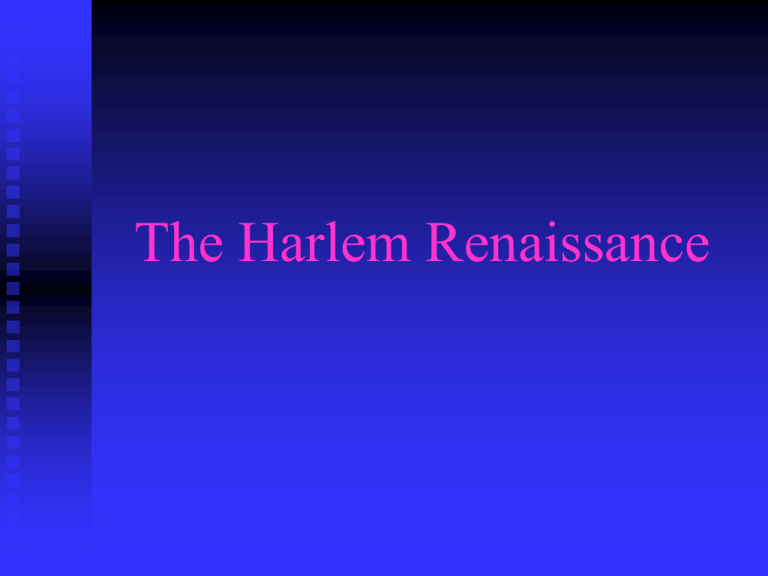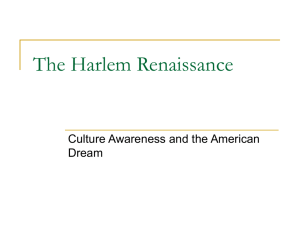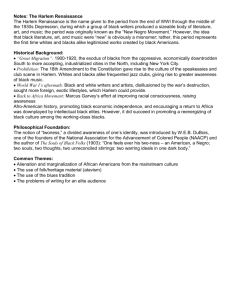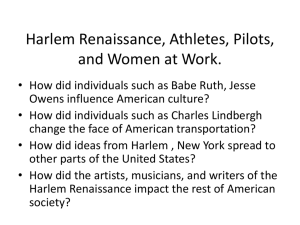The Harlem Renaissance
advertisement

The Harlem Renaissance What was the Harlem Renaissance? African American cultural movement of the 1920’s and early 30’s Centered in Harlem Consisted of African American literature, art, and music 1st time in American history that black artists could earn their livings and be critically acclaimed in these fields The Beginnings I. Factors Leading to the Harlem Renaissance A. Development of a Black Middle Class B. The Great Migration C. Political Agenda Promoting Equal Rights A. The Black Middle Class Developed by 1900 Increased Education of African Americans Increased Employment Opportunities B. The Great Migration Movement of African Americans from the South to the North 1900-1930 One Million African Americans moved North 1900-1920 Black population of Harlem Doubled Why Move? Depression in the Agricultural South WWI Industrial Boom in the North Growing Oppression and Racism in the South Better Quality of Life Why Harlem? Available housing New York was the cultural center of America The black population in Harlem was large200,000 by 1930 National headquarters for recently founded protest and political groups-NAACP and the Urban League C. Political Agenda Promoting Equal Rights Characteristics No common style or political ideology Common themes: Africa, American South, Racial Pride, Social & Political Equality Appealed to a mixed audience Founders of the Harlem Renaissance Alain Leroy Locke W.E.B. DuBois Alain Leroy Locke Born in Philadelphia September 13, 1886 Ph.D. in philosophyHarvard Professor Howard University Cultural Pluralism: each culture group has its own identity and it is entitled to protect and promote it W.E.B. DuBois William Edward Burghardt DuBois Ph.D Harvard Helped form NAACP Editor of The Crisis Extremely influential in the literary world of the Harlem Renaissance “The problem of the twentieth century is the problem of the color-line.” -DuBois W.E.B. Du Bois’ The Souls of Black Folk “Leaving, then, the world of the white man, I have stepped within the Veil, raising it that you may view faintly its deeper recesses,the meaning of its religion, the passion of its human sorrow, and the struggle of its greater souls.” From: “The Forethought” “Of Our Spiritual Strivings” W.E.B.DuBois “Between me and the other world there is ever an unasked question: unasked by some through feelings of delicacy; by others through the difficulty of rightly framing it. All, nevertheless, flutter round it. They approach me in a halfhesitant sort of way, eye me curiously or compassionately, and then, instead of saying directly, How does it feel to be a problem? They say, I know an excellent colored man in my town; or, I fought at Mechanicsville; or, Do not these Southern outrages make your blood boil? At these I smile, or am interested, or reduce the boiling to a simmer, as the occasion may require. To the real question, How does it feel to be a problem? I answer seldom a word.” From: The Souls of Black Folk The NAACP National Association for the Advancement of Colored People Founded by 60 peopleblack & white-on Abraham Lincoln’s birthday, 1909 Purpose: improving the conditions under which black Americans lived The Crisis Founded 1910 by Du Bois Published by the NAACP Became the most influential and prestigious black periodical in American history Circulation: 1910-1,750 per issue; 1919-94,908 per issue, some topping 100,000 Literature and the Harlem Renaissance Writers of the Harlem Renaissance Claude McKay Countee Cullen Langston Hughes Zora Neale Hurston Claude McKay September 15, 1890 Born in Jamaica Immigrated in 1912 Socialist editor of The Liberator 1st two poems published in 1917 under a pseudonym Red Summer of 1919 led to his best known poem “If We Must Die” 1922-Harlem Shadows one of the first works by a black writer to be published by a mainstream, national publisher Countee Cullen March 30, 1903 Adopted Masters in English and French from Harvard Won more major literary awards than any other black writer in the 1920s “Crossover” artist in that he was known for his ability to write “white” verse-ballads, quatrains, and sonnets Langston Hughes Born 1902, Joplin, Missouri June 1921-“The Negro Speaks of Rivers” published in The Crisis Sept. 1921-Moved to New York to attend Columbia University, and participate in Harlem life 1922-1924 traveled abroad By 1926 considered a major force in the Harlem Renaissance Popular Works by Hughes Poems “The Negro Speaks of Rivers” “Harlem” renamed “Dream Deferred” “I, Too” “The Weary Blues” “Dream Variations” “Mother to Son” Books and Essays The Weary Blues Fine Clothes to the Jew The Ways of White Folks Simple Speaks His Mind “The Negro Artist and the Racial Mountain” Zora Neale Hurston January 7, 1891 Eatonville, FL-1st incorporated black community in America Novelist, folklorist, anthropologist Columbia University Authority on Black Culture during the Harlem Renaissance A Utopian 1934-Jonah’s Gourd Vine 1937-Their Eyes Were Watching God Died 1960 in poverty and obscurity Literary Events of the Harlem Renaissance March 21, 1924-Charles S. Johnson (National Urban League) held a dinner to recognize black writers and to introduce them to the white literary establishment 1926-White novelist Carl Van Vechten publishes a novel that portrayed life in Harlem, creating a “Negro vogue” 1926-The magazine Fire!! was published by a group of young black writers including Hughes and Hurston The End of the Harlem Renaissance Ended in the 1930s The Great Depression Organizations such as NAACP & NUL shifted focus to economic and social issues Many writers and promoters left NYC including Du Bois and Hughes Riot in Harlem in 1935 Lasting Effects Changed the face of African American arts in the United States Opened the door for future writers, as publishers and the public were more open to African American literature Acted as inspiration to future writers, painters, and musicians





